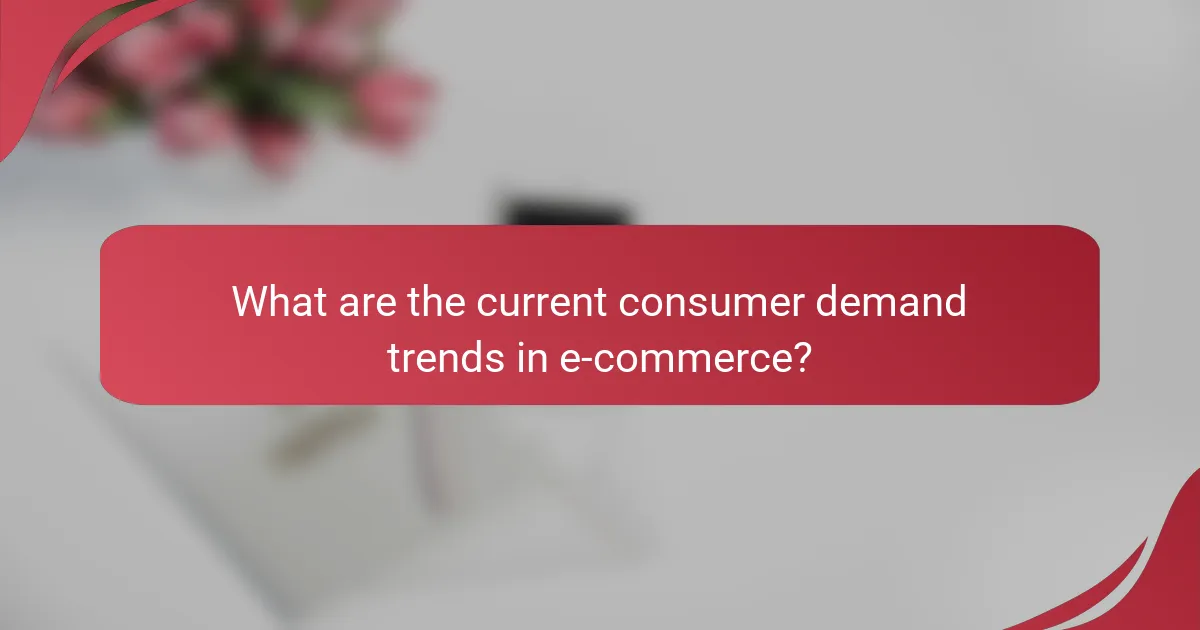The current landscape of e-commerce is shaped by evolving consumer demand, with a strong emphasis on sustainability, personalization, and convenience through subscription models. As technology adoption accelerates, businesses are harnessing advanced tools to enhance customer experiences and streamline operations. In this competitive environment, understanding the interplay between dominant players, emerging brands, and social media influences is essential for success.

What are the current consumer demand trends in e-commerce?
Current consumer demand trends in e-commerce reflect a shift towards sustainability, personalization, and subscription models. These trends indicate how consumers are increasingly prioritizing ethical choices, tailored experiences, and convenience in their shopping habits.
Increased demand for sustainable products
Consumers are showing a strong preference for sustainable products, driven by growing environmental awareness. Many shoppers now seek items that are eco-friendly, ethically sourced, and produced with minimal environmental impact.
Brands that emphasize sustainability in their marketing and product offerings often see increased loyalty and sales. For example, companies that use biodegradable packaging or sustainable materials can attract environmentally conscious buyers.
Growth in personalized shopping experiences
Personalization in e-commerce is becoming essential as consumers expect tailored experiences. Retailers are leveraging data analytics to provide recommendations based on individual preferences, browsing history, and purchase behavior.
Effective personalization can significantly enhance customer satisfaction and conversion rates. For instance, personalized email campaigns or customized product suggestions on websites can lead to higher engagement and sales.
Rise of subscription-based services
Subscription-based services are gaining traction as they offer convenience and value to consumers. This model allows customers to receive products regularly, often at a discounted rate, which enhances customer retention.
Examples include meal kits, beauty boxes, and streaming services. Businesses adopting this model should focus on delivering consistent quality and unique offerings to maintain subscriber interest and reduce churn rates.

How is technology adoption shaping e-commerce?
Technology adoption is significantly transforming e-commerce by enhancing customer experiences and streamlining operations. Businesses are increasingly leveraging advanced tools to meet consumer demands, improve service efficiency, and stay competitive in a rapidly evolving market.
Integration of AI for customer service
The integration of artificial intelligence (AI) in customer service is revolutionizing how e-commerce businesses interact with their customers. AI-powered chatbots and virtual assistants can handle inquiries 24/7, providing instant responses and personalized recommendations based on user behavior.
Companies should consider implementing AI solutions to reduce response times and improve customer satisfaction. However, it’s crucial to ensure that these systems are well-trained to avoid misunderstandings and maintain a human touch in interactions.
Use of AR for virtual try-ons
Augmented reality (AR) technology allows customers to virtually try on products, enhancing their shopping experience. This is particularly popular in the fashion and beauty sectors, where consumers can see how clothing or makeup looks on them before making a purchase.
Retailers should invest in AR solutions to increase engagement and reduce return rates. Providing a seamless AR experience can significantly boost consumer confidence in their buying decisions, leading to higher conversion rates.
Expansion of mobile commerce platforms
The expansion of mobile commerce platforms is reshaping e-commerce by making shopping more accessible. With a growing number of consumers using smartphones for purchases, businesses must optimize their websites and apps for mobile use to capture this audience effectively.
To succeed, retailers should focus on creating user-friendly mobile experiences, ensuring fast load times, and offering secure payment options. Ignoring mobile optimization can lead to lost sales, as consumers expect convenience and efficiency when shopping on their devices.

What is the competitive landscape in the e-commerce market?
The competitive landscape in the e-commerce market is characterized by a few dominant players, emerging niche brands, and the influence of social media on consumer choices. Understanding these dynamics is crucial for businesses looking to thrive in this rapidly evolving sector.
Dominance of Amazon in online retail
Amazon remains the leading force in online retail, holding a significant share of the market. Its vast product selection, competitive pricing, and efficient logistics give it an edge over many competitors.
Retailers must consider how to differentiate themselves from Amazon. Strategies may include offering unique products, exceptional customer service, or specialized shopping experiences that Amazon cannot replicate.
Emergence of niche market players
Niche market players are gaining traction by focusing on specific consumer segments or product categories. These businesses often cater to specialized interests, such as eco-friendly products or handmade goods, which can foster strong brand loyalty.
To succeed, niche players should leverage their unique selling propositions and build communities around their brands. Engaging with customers through targeted marketing and personalized experiences can enhance customer retention.
Impact of social media on brand competition
Social media significantly influences brand competition by shaping consumer perceptions and driving purchasing decisions. Brands that effectively utilize platforms like Instagram and TikTok can reach wider audiences and engage customers in innovative ways.
Companies should invest in social media marketing strategies that highlight their products and values. Collaborations with influencers and user-generated content can enhance visibility and credibility, making it essential for brands to maintain an active and authentic online presence.

What factors influence consumer purchasing decisions?
Consumer purchasing decisions are influenced by various factors, including price sensitivity, brand reputation, and logistics such as shipping speed. Understanding these elements helps businesses tailor their strategies to meet consumer expectations and enhance sales.
Price sensitivity and discount offerings
Price sensitivity refers to how changes in price affect consumer purchasing behavior. Many consumers actively seek discounts and promotions, particularly during sales events or holiday seasons, which can significantly influence their buying decisions.
Businesses should consider offering competitive pricing or limited-time discounts to attract price-sensitive customers. For instance, implementing tiered pricing strategies or loyalty programs can encourage repeat purchases while maintaining profit margins.
Brand reputation and reviews
Brand reputation plays a crucial role in consumer trust and purchasing decisions. Positive reviews and strong brand recognition can lead to increased sales, while negative feedback can deter potential buyers.
Encouraging satisfied customers to leave reviews and addressing any negative feedback promptly can enhance a brand’s reputation. Companies should actively manage their online presence and consider using social proof to build credibility.
Shipping speed and return policies
Shipping speed and return policies are critical factors in the consumer decision-making process. Fast shipping options, such as same-day or next-day delivery, can significantly enhance customer satisfaction and encourage purchases.
Clear and flexible return policies also improve consumer confidence. Offering free returns or easy exchange processes can reduce the perceived risk of online shopping, making customers more likely to complete their purchases.

How do demographic shifts affect e-commerce trends?
Demographic shifts significantly influence e-commerce trends by altering consumer preferences and shopping behaviors. As different age groups engage with technology and online shopping in unique ways, businesses must adapt their strategies to meet these evolving demands.
Millennials driving online shopping growth
Millennials are a key demographic in the expansion of online shopping, often prioritizing convenience and speed. This generation values seamless digital experiences, leading to increased demand for mobile-friendly websites and fast shipping options.
Retailers should focus on enhancing their online platforms and consider offering subscription services or loyalty programs to retain this tech-savvy group. Engaging marketing strategies that leverage social media can also effectively capture their attention.
Gen Z preferences for ethical brands
Gen Z consumers are increasingly drawn to brands that demonstrate ethical practices and social responsibility. This generation tends to research companies’ values before making purchases, favoring those that align with their beliefs on sustainability and social justice.
To appeal to Gen Z, businesses should highlight their commitment to ethical sourcing, environmental sustainability, and community engagement. Transparency in supply chains and authentic storytelling can enhance brand loyalty among these young shoppers.
Aging population adapting to online shopping
The aging population is gradually embracing online shopping, driven by the need for convenience and accessibility. Many seniors are becoming more comfortable with technology, leading to a rise in e-commerce tailored to their needs.
Retailers should consider user-friendly website designs and customer support options to assist older consumers. Offering clear product descriptions, easy navigation, and simplified checkout processes can enhance the online shopping experience for this demographic.

What are the key performance indicators for e-commerce success?
Key performance indicators (KPIs) for e-commerce success include metrics that directly reflect the effectiveness of online sales strategies. Understanding these indicators helps businesses optimize their operations and improve profitability.
Conversion rates and cart abandonment
Conversion rates measure the percentage of visitors who make a purchase. A typical conversion rate for e-commerce sites ranges from 1% to 3%, but this can vary based on industry and target audience. High cart abandonment rates, often around 60-80%, indicate potential issues in the checkout process or pricing strategies.
To improve conversion rates, ensure a seamless user experience, offer competitive pricing, and provide clear calls to action. Reducing cart abandonment can involve simplifying the checkout process, offering guest checkout options, and sending follow-up emails to remind customers of their abandoned carts.
Customer lifetime value and retention rates
Customer lifetime value (CLV) estimates the total revenue a business can expect from a single customer over their relationship. A high CLV indicates effective customer engagement and loyalty strategies. Retention rates, which measure the percentage of customers who return for repeat purchases, are crucial for long-term profitability.
To enhance CLV and retention, focus on personalized marketing, loyalty programs, and excellent customer service. Businesses should aim for retention rates above 30% to ensure a sustainable customer base.
Website traffic and engagement metrics
Website traffic refers to the number of visitors to an e-commerce site, while engagement metrics include time spent on site, pages per visit, and bounce rates. High traffic combined with strong engagement suggests effective marketing and user experience strategies.
To boost traffic, consider SEO optimization, social media marketing, and paid advertising. Engaging content and user-friendly design can help keep visitors on the site longer, ideally aiming for an average session duration of over 2 minutes and a bounce rate below 40%.


